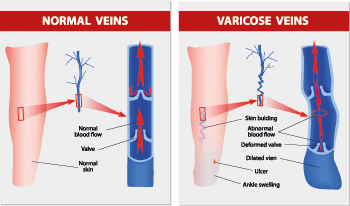Varicose Vein Surgery and Treatment
Varicose veins are enlarged veins under the skin of the leg that have become twisted and widened with often a blue and purple look to them.

Varicose veins are extremely common and do not cause any sort of medical problem in most people. For many it is the fact they are cosmetically unsightly that is the largest concern.
There are two types of vein systems in the leg:
- Superficial veins occuring under the skin which can form varicose veins, these veins are of less importance than the deep veins.
- Deep veins are veins that carry blood up to the heart. When wlaking the leg muscles contract and squeeze the veins to release the blook back up to the chest.
Veins carry blood to the heart with the veins in the legs having to work harder to pump the blood that distance. On the veins are valves which allow blood to pass only one way, if the valves start to malfunction there becomes a build up of blood around that valve causing enlargement and discolouring.

There are a number of treatment options for varicose veins, however surgery is the only way to completely remove the offending veins. Options include:
- sclerotherapy (or injection)
- laser therapy
Both techniques are non invasive and require a course of treatment.
Surgery will require a general anaesthetic and will last approximately one hour.
A mark will be made next to the offending vein and that vein removed via a small incision in the back of the knee or the groin. In some cases if the vein is long further incisions will be made in the relevant areas to further remove the vein. All cuts will be stitched and bandaged after the operation.
A leg bandage and support stockings will be used to keep the pressure on the leg to avoid bleeding and bruising.
Patients will be allowed home on the same day as the operation but will need to be collected from the hospital following the anaesthetic.
We advise in the days following the operation to keep the leg elevated and to try and return to normal exercise as regularly as possible to aid the process.
You should be able to return to work within two weeks of the operation and normal activity around the same time.
It is important to discuss any questions with the consultants prior to any procedure.
This procedure will normally be covered by the medical insurance policy but patients are advised to check with the provider prior to any treatment.
If you are paying for your own treatment all costs will be discussed and explained prior to any treatment taking place. This will be confirmed in writing along with any surgeon fees, anaesthetist fees and hospital charges prior to admission.